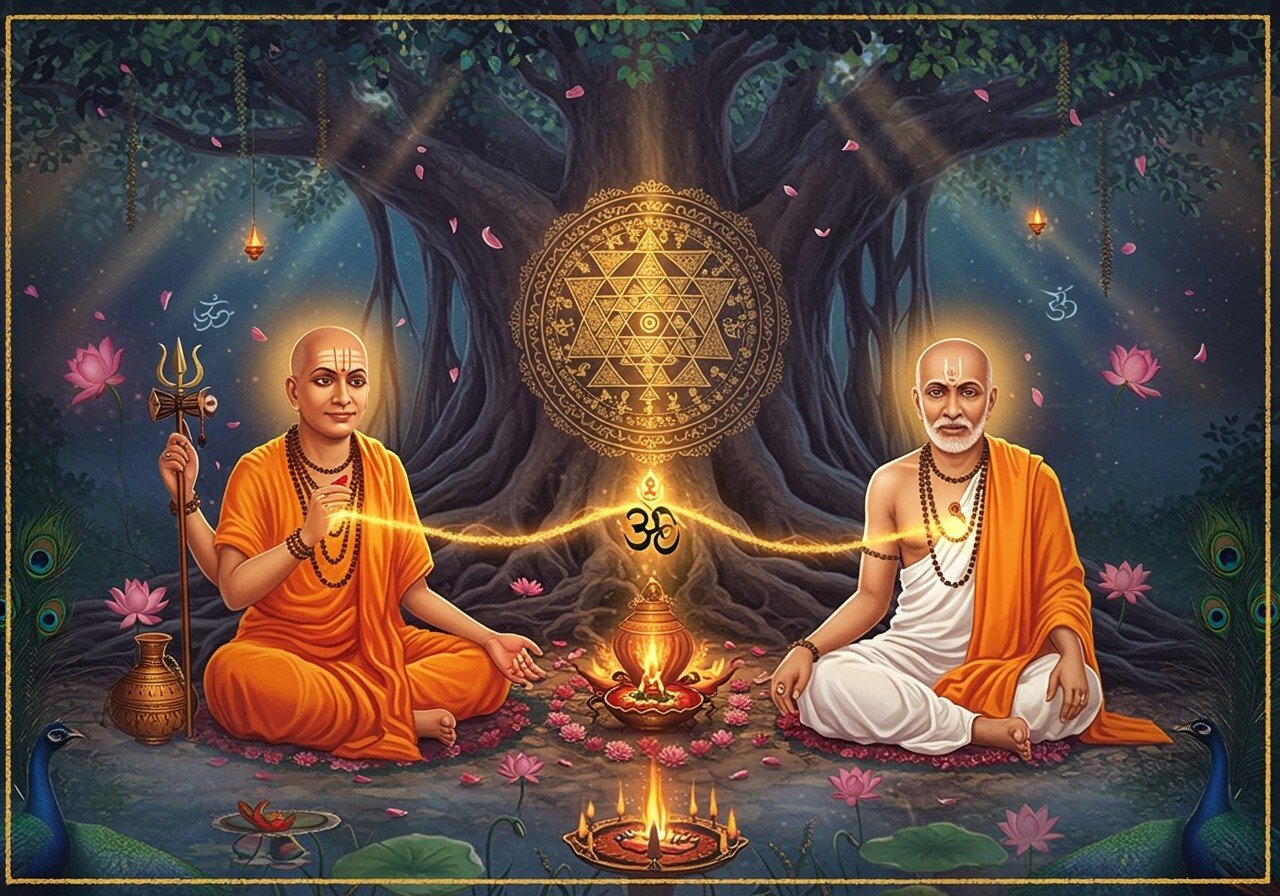
The connection between Narasimha Saraswati and Swami Samarth offers valuable insights into Indian spirituality. Both figures have left a lasting impact on their followers through profound teachings and miraculous events. This blog explores their lives, spiritual journeys, and the relevance of their teachings in today’s world, especially for those who cherish tradition and spirituality. For devotees seeking to enhance their spiritual practice, Poojn.in offers a wide selection of puja items, including pure copper vessels and traditional puja accessories.
Historical Background of Narasimha Saraswati
Narasimha Saraswati, a revered figure in the Dattatreya tradition, was born in the 14th century. He displayed spiritual inclinations from a young age, eventually renouncing worldly pursuits for a spiritual path. His teachings, centered around devotion, meditation, and self-realization, guided numerous followers. Miracles and significant life events solidified his status as a divine guru, particularly in Maharashtra, where his influence continues to inspire spiritual seekers.
Swami Samarth’s Spiritual Journey
Swami Samarth’s origins remain shrouded in mystery, with his arrival in Akkalkot woven in legend. His teachings, while echoing those of Narasimha Saraswati, possessed unique elements that resonated with devotees. Swami Samarth’s miracles and spiritual guidance, emphasizing devotion and meditation, have left a lasting legacy. His teachings on peace and self-discipline continue to enrich the Dattatreya tradition and inspire spiritual communities today.
The Connection between Narasimha Saraswati and Swami Samarth
The Dattatreya tradition forms the basis of the connection between Narasimha Saraswati and Swami Samarth. Historical and spiritual evidence suggests a link, often explored through the concept of reincarnation. Both gurus shared spiritual objectives, focusing on devotion and self-realization. This connection enriches the Dattatreya tradition, deepening followers’ understanding of spirituality and the continuity of teachings.
Successive Incarnations
Many believe Swami Samarth to be an incarnation of Narasimha Saraswati, who himself is considered an incarnation of Shripad Shrivallabha. This lineage positions all three as Avatars of Lord Dattatreya, creating a continuous spiritual thread.
Guru Charitra
The ‘Guru Charitra’ offers valuable insights into Narasimha Saraswati’s life and teachings. It serves as an important resource for followers seeking a deeper understanding of his spiritual journey. You can find resources and items related to this spiritual lineage at Poojn.in.
Samadhi and Reappearance
Tradition holds that Narasimha Saraswati entered Samadhi in 1459. Around 300 years later, he reportedly reappeared as Swami Samarth. A woodcutter’s accidental strike on the anthill encasing him is said to have awakened Narasimha Saraswati, who then became known as Swami Samarth. Devotees seeking to connect with Swami Samarth’s teachings can find various spiritual resources at Poojn.in.
Kardali Forest
Swami Samarth himself stated his origin to be the Kardali forests near Srisailam. This location holds spiritual significance for devotees. To deepen your understanding of this spiritual history, consider exploring resources available at Poojn.in.
Lineage and Influence
Narasimha Saraswati is a revered Guru in the Datta-Sampradaya community, his lineage continuing to guide followers on their spiritual paths. Enhance your connection to this lineage with puja items from Poojn.in.
Teachings and Philosophies
Devotion, meditation, and self-realization form the core teachings of both Narasimha Saraswati and Swami Samarth. They advocated for a balance between worldly responsibilities and spiritual pursuits, promoting peace, compassion, and self-discipline. Their philosophies significantly influence spiritual practices within the Dattatreya tradition, with specific texts and anecdotes illuminating their wisdom for those seeking spiritual growth. Learn more about Saraswati Puja and its significance at Poojn.in.
Cultural and Spiritual Impact
Narasimha Saraswati and Swami Samarth have profoundly influenced Indian spirituality and cultural practices. Their teachings shape religious rituals, festivals, and daily observances within the Dattatreya tradition. Their impact resonates in the modern spiritual landscape, fostering a sense of community among followers who share common spiritual goals. Understanding this rich heritage provides insights into their spiritual journeys and the enduring wisdom they imparted. Their legacy inspires those dedicated to preserving tradition while embracing spirituality. Explore different Saraswati Puja traditions across India.
Embracing the Spiritual Legacy
Exploring the connection between Narasimha Saraswati and Swami Samarth reveals a profound journey within the Dattatreya tradition. Their teachings, emphasizing devotion and self-realization, continue to inspire followers today. Understanding their lives and spiritual contributions enhances our appreciation for Indian spirituality. Those seeking guidance on balancing worldly and spiritual life can find direction in their teachings of peace and discipline. Their legacy, embedded in cultural practices, encourages preserving tradition while embracing our inner spiritual journey. Reflecting on their lives reminds us of the enduring connection between past, present, and future, guiding us towards a deeper understanding of devotion and enlightenment. You can find various spiritual resources at Poojn.in.
FAQs: Narasimha Saraswati and Swami Samarth
What is the connection between Narasimha Saraswati and Swami Samarth? Narasimha Saraswati is believed to be an earlier incarnation of Swami Samarth. Both are revered in the Dattatreya tradition, with followers believing Swami Samarth continued Narasimha Saraswati’s spiritual work. This lineage is often explored through texts like the Guru Charitra and is a central theme in the Dattatreya tradition.
Who was Narasimha Saraswati? Narasimha Saraswati, a revered saint and incarnation of Lord Dattatreya, is known for his teachings and miracles. He championed devotion and righteousness, inspiring countless followers on their spiritual path. His life and teachings are often studied alongside Swami Samarth’s, emphasizing their shared spiritual lineage.
Who was Swami Samarth? Also known as Akkalkot Maharaj, Swami Samarth was a spiritual leader believed to be an incarnation of Narasimha Saraswati. He is revered for his teachings and miracles, which emphasized devotion and righteousness, particularly within the Dattatreya tradition. His connection to Narasimha Saraswati reinforces the concepts of reincarnation and continued spiritual lineages.
Why are Narasimha Saraswati and Swami Samarth important in Hinduism? These saints spread the teachings of Lord Dattatreya, promoting peace, devotion, and righteousness, inspiring countless followers. Their lives and teachings continue to resonate with those seeking spiritual guidance within the Hindu tradition.
Where did Narasimha Saraswati and Swami Samarth live? Narasimha Saraswati (14th century) spent much of his life in India’s Deccan region, while Swami Samarth (19th century) mainly resided in Akkalkot, Maharashtra. These locations hold significance for their followers and are often visited as places of pilgrimage.
What are the teachings of Narasimha Saraswati and Swami Samarth? Their teachings emphasized devotion, compassion, humility, and righteous living. They stressed faith in God and dedication to spiritual practice. These principles are considered cornerstones of the Dattatreya tradition.
How can one follow the teachings of Narasimha Saraswati and Swami Samarth today? One can follow their teachings through regular prayer, meditation, acts of kindness, scripture study, and visits to their holy places. These practices allow individuals to connect with their spiritual essence and incorporate their teachings into daily life. Resources to support these practices are available at Poojn.in.


